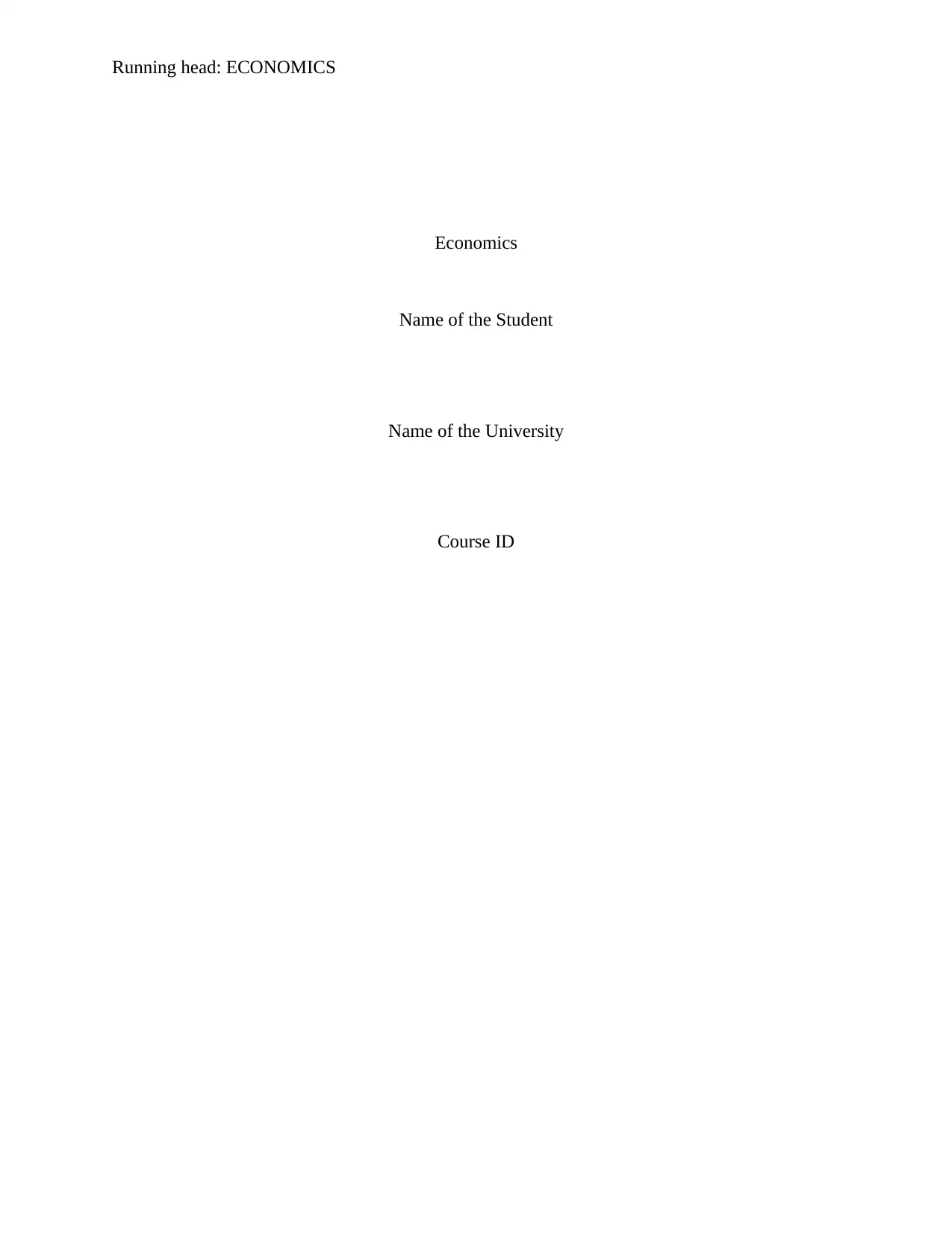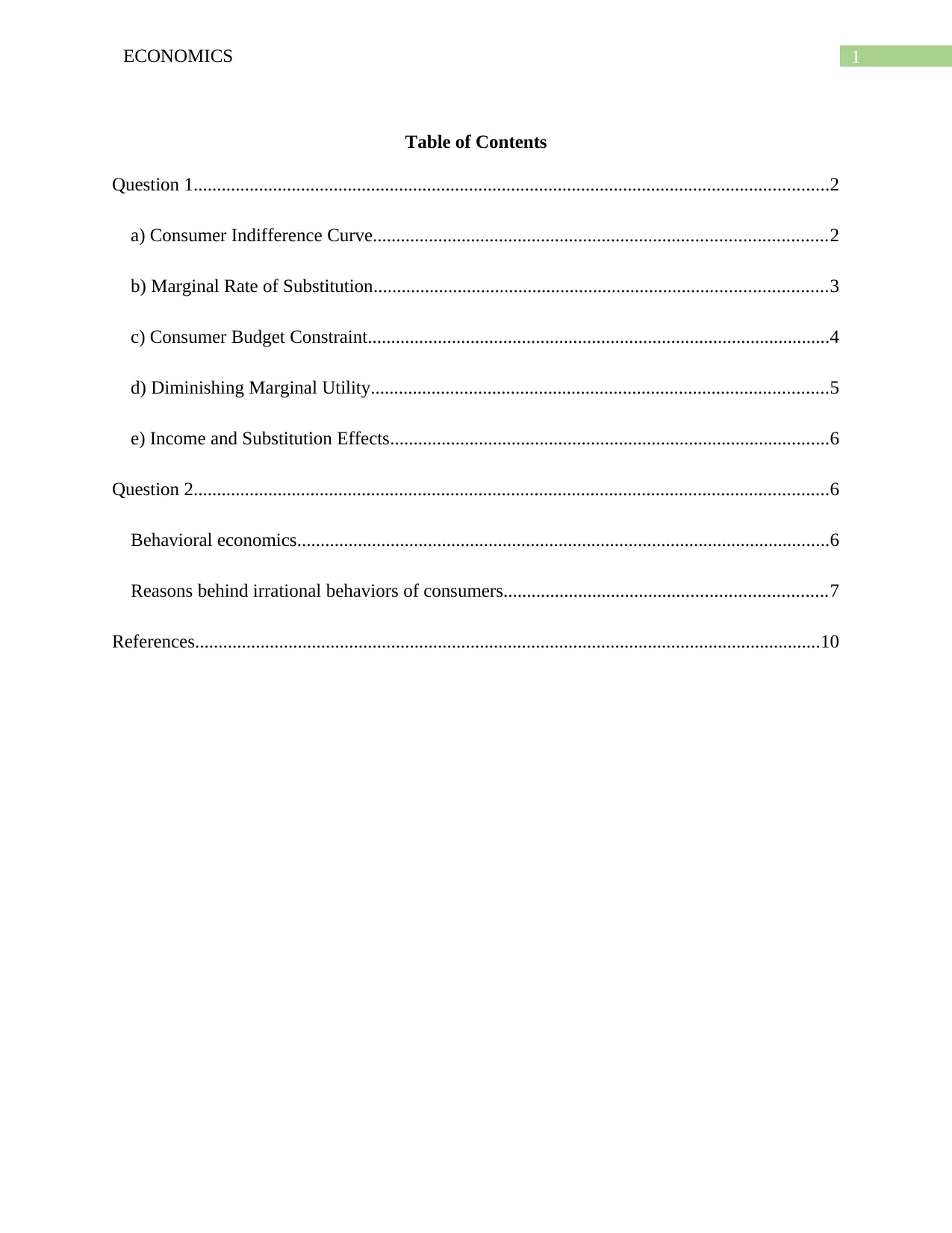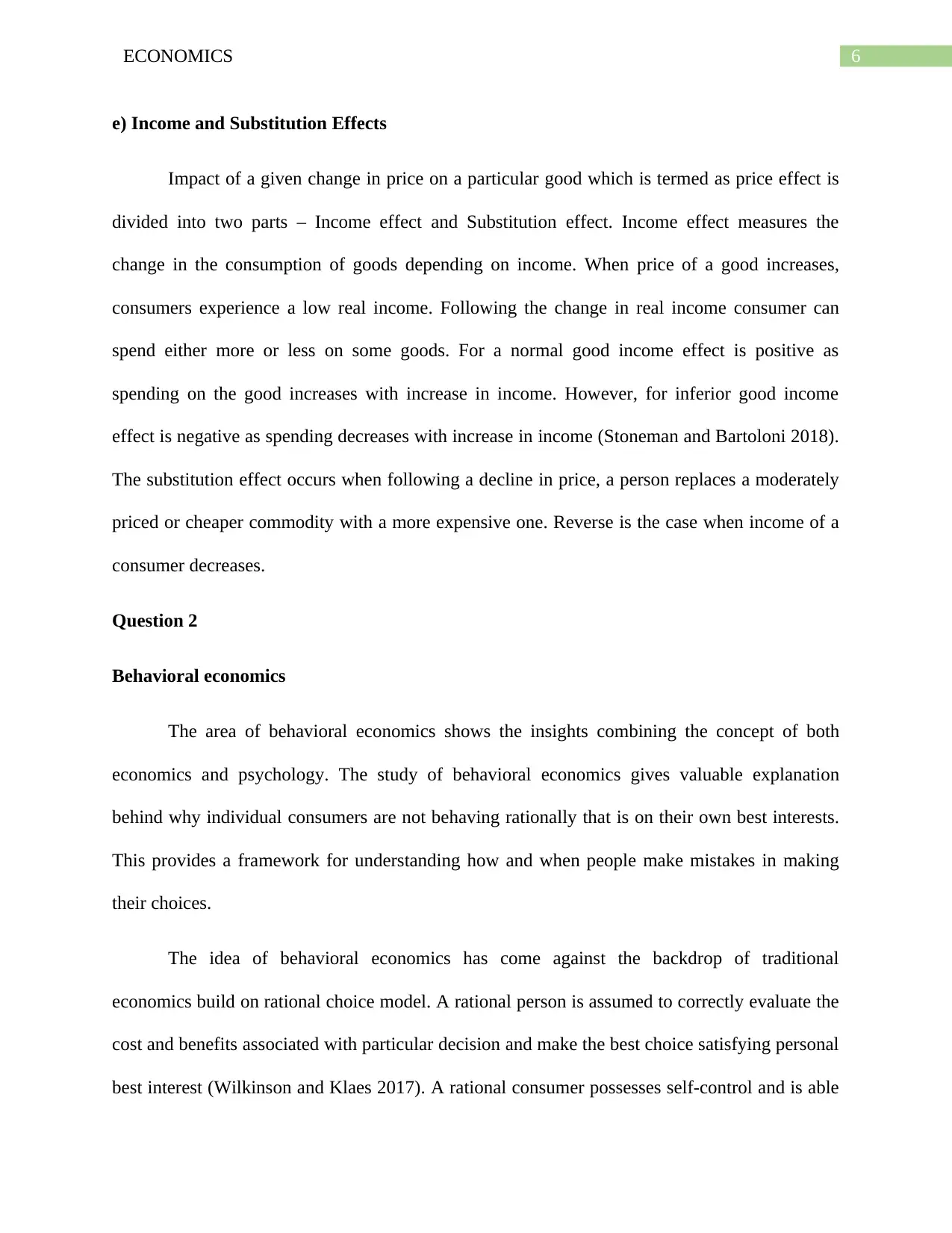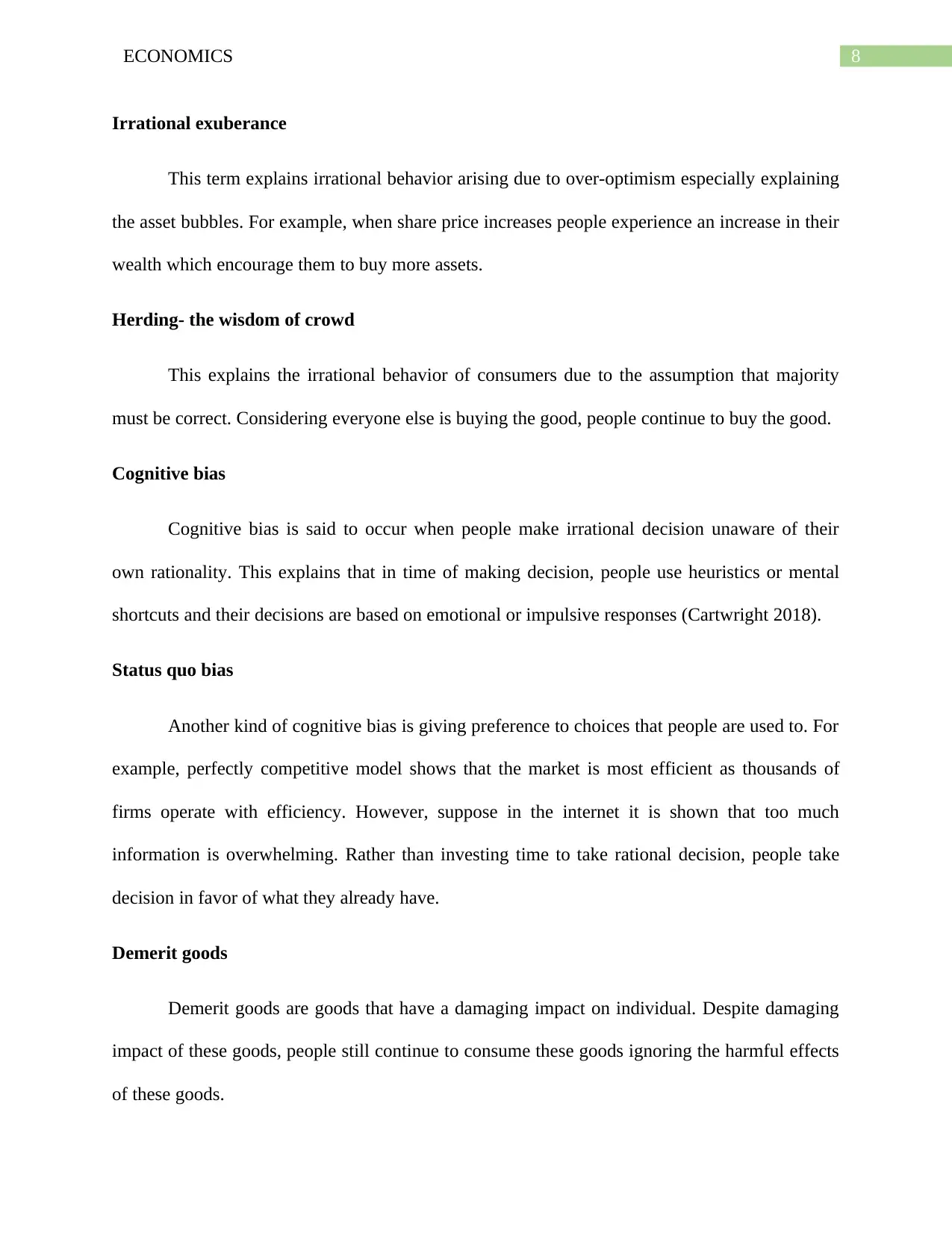University Economics Assignment: Consumer Behavior Analysis
VerifiedAdded on 2022/10/10
|11
|1822
|254
Homework Assignment
AI Summary
This economics assignment addresses key concepts in microeconomics and behavioral economics. Question 1 delves into consumer behavior, defining and explaining indifference curves, marginal rate of substitution, consumer budget constraints, diminishing marginal utility, and income and substitution effects. Question 2 explores behavioral economics, explaining its principles and critically evaluating the reasons behind irrational consumer behaviors, such as cognitive biases, heuristics, and market inefficiencies. The assignment integrates economic theory with real-world examples, providing a comprehensive analysis of consumer decision-making processes and deviations from rational behavior, supported by relevant academic references.

Running head: ECONOMICS
Economics
Name of the Student
Name of the University
Course ID
Economics
Name of the Student
Name of the University
Course ID
Paraphrase This Document
Need a fresh take? Get an instant paraphrase of this document with our AI Paraphraser

1ECONOMICS
Table of Contents
Question 1........................................................................................................................................2
a) Consumer Indifference Curve.................................................................................................2
b) Marginal Rate of Substitution.................................................................................................3
c) Consumer Budget Constraint...................................................................................................4
d) Diminishing Marginal Utility..................................................................................................5
e) Income and Substitution Effects..............................................................................................6
Question 2........................................................................................................................................6
Behavioral economics..................................................................................................................6
Reasons behind irrational behaviors of consumers.....................................................................7
References......................................................................................................................................10
Table of Contents
Question 1........................................................................................................................................2
a) Consumer Indifference Curve.................................................................................................2
b) Marginal Rate of Substitution.................................................................................................3
c) Consumer Budget Constraint...................................................................................................4
d) Diminishing Marginal Utility..................................................................................................5
e) Income and Substitution Effects..............................................................................................6
Question 2........................................................................................................................................6
Behavioral economics..................................................................................................................6
Reasons behind irrational behaviors of consumers.....................................................................7
References......................................................................................................................................10

2ECONOMICS
Question 1
a) Consumer Indifference Curve
Indifference curve is an important microeconomics concept used for studying behavior of
consumers. An indifference curve represents a graph showing different combination of two
goods that give consumers equal level of utility and satisfaction. This is a heuristic tool used in
the contemporary economics that is used to illustrate preferences of consumers and limitation in
consumer budget (Kreps 2019). Recently, the principles of indifference curves is used in welfare
economics.
A standard indifference curve is plotted on a two dimensional framework. Each axis
measures one type of good. Along the curve each combination of two goods ensures same level
satisfaction to the consumer.
Figure 1: Indifference curve
There are some basic assumption behind the theory of indifference curve. These are as
follows
Question 1
a) Consumer Indifference Curve
Indifference curve is an important microeconomics concept used for studying behavior of
consumers. An indifference curve represents a graph showing different combination of two
goods that give consumers equal level of utility and satisfaction. This is a heuristic tool used in
the contemporary economics that is used to illustrate preferences of consumers and limitation in
consumer budget (Kreps 2019). Recently, the principles of indifference curves is used in welfare
economics.
A standard indifference curve is plotted on a two dimensional framework. Each axis
measures one type of good. Along the curve each combination of two goods ensures same level
satisfaction to the consumer.
Figure 1: Indifference curve
There are some basic assumption behind the theory of indifference curve. These are as
follows
⊘ This is a preview!⊘
Do you want full access?
Subscribe today to unlock all pages.

Trusted by 1+ million students worldwide

3ECONOMICS
Two commodities
Non-Satiety
Ordinal utility
Diminishing marginal rate of substitution
Rationality of consumers
Indifference curve drawn on the basis of above mentioned assumption has the following
properties
Indifference curve slopes downward to right
Indifference curve convex to the origin
No two indifference curve can intersect each other (Cowell 2018).
Higher indifference curve shows higher level of satisfaction
b) Marginal Rate of Substitution
In microeconomics analysis, marginal rate of substitution indicates amount of a good that
a consumer is willing to sacrifice to consume one additional unit of another good, given the good
gives equal level of satisfaction to the consumer. The concept is mainly used in the theory of
indifference curve analysis. MRS is computed between the two goods shown on the indifference
showing frontier of equal utility of each combination of two goods. The formula for marginal
rate of substitution is given as
MRSX ,Y = MU X
MU Y
Two commodities
Non-Satiety
Ordinal utility
Diminishing marginal rate of substitution
Rationality of consumers
Indifference curve drawn on the basis of above mentioned assumption has the following
properties
Indifference curve slopes downward to right
Indifference curve convex to the origin
No two indifference curve can intersect each other (Cowell 2018).
Higher indifference curve shows higher level of satisfaction
b) Marginal Rate of Substitution
In microeconomics analysis, marginal rate of substitution indicates amount of a good that
a consumer is willing to sacrifice to consume one additional unit of another good, given the good
gives equal level of satisfaction to the consumer. The concept is mainly used in the theory of
indifference curve analysis. MRS is computed between the two goods shown on the indifference
showing frontier of equal utility of each combination of two goods. The formula for marginal
rate of substitution is given as
MRSX ,Y = MU X
MU Y
Paraphrase This Document
Need a fresh take? Get an instant paraphrase of this document with our AI Paraphraser

4ECONOMICS
At a given point on indifference curve, the marginal rate of substitution measures slope of
IC on that point (McKenzie and Lee 2016). On an indifference curve marginal rate of
substitution diminishes along the curve making an indifference curve downward sloping.
c) Consumer Budget Constraint
Objective of a consumer is to maximize the utility or satisfaction. This is however
constraint by the limited money income or budget. Budget line of a consumer is defined by the
affordable combination of two goods with the given prices of the goods and income of the
consumer. Budget constraint thus is defined as various combination of two goods that is
affordable to the consumer.
Suppose a consumer earns a fixed money income M. The fixed income is spent on two
goods X and Y. Respective prices of X and Y are given as PX and PY. The prices of X and Y are
also fixed. Total expenditure on X and Y therefore can be presented as
PX . X +PY .Y
Given money income M, the budget constraint of a consumer is given by
PX . X + PY .Y ≤ M
Graphically, the budget constraint can be presented by a straight line with vertical and horizontal
intercept being M/PY and M/PX respectively (Pouw 2017). Slope of a budget line is given by –
PX/PY.
At a given point on indifference curve, the marginal rate of substitution measures slope of
IC on that point (McKenzie and Lee 2016). On an indifference curve marginal rate of
substitution diminishes along the curve making an indifference curve downward sloping.
c) Consumer Budget Constraint
Objective of a consumer is to maximize the utility or satisfaction. This is however
constraint by the limited money income or budget. Budget line of a consumer is defined by the
affordable combination of two goods with the given prices of the goods and income of the
consumer. Budget constraint thus is defined as various combination of two goods that is
affordable to the consumer.
Suppose a consumer earns a fixed money income M. The fixed income is spent on two
goods X and Y. Respective prices of X and Y are given as PX and PY. The prices of X and Y are
also fixed. Total expenditure on X and Y therefore can be presented as
PX . X +PY .Y
Given money income M, the budget constraint of a consumer is given by
PX . X + PY .Y ≤ M
Graphically, the budget constraint can be presented by a straight line with vertical and horizontal
intercept being M/PY and M/PX respectively (Pouw 2017). Slope of a budget line is given by –
PX/PY.

5ECONOMICS
Figure 2: Budget line
d) Diminishing Marginal Utility
In the theory of consumer behavior, the concept of utility is used to measure the level of
satisfaction that a person get from consuming a particular good. Total utility is the total
satisfaction obtained from consuming the good. Marginal utility is the change in total utility due
to consumption of one additional unit of the good. As a person consumes more and more units of
a good, the additional utility obtained from the good diminishes. This phenomenon is explained
by the law of diminishing marginal utility. The law states that marginal utility associated with a
particular good or service diminishes with increase in available supply of the good (Baumol and
Blinder 2015). As a person consumes an economic good, behavior of the individual depends on
the value associated with the good. Hence, a consumer gets maximum utility from the first unit
of the good. The second unit is devoted to second most important value and so on.
Figure 2: Budget line
d) Diminishing Marginal Utility
In the theory of consumer behavior, the concept of utility is used to measure the level of
satisfaction that a person get from consuming a particular good. Total utility is the total
satisfaction obtained from consuming the good. Marginal utility is the change in total utility due
to consumption of one additional unit of the good. As a person consumes more and more units of
a good, the additional utility obtained from the good diminishes. This phenomenon is explained
by the law of diminishing marginal utility. The law states that marginal utility associated with a
particular good or service diminishes with increase in available supply of the good (Baumol and
Blinder 2015). As a person consumes an economic good, behavior of the individual depends on
the value associated with the good. Hence, a consumer gets maximum utility from the first unit
of the good. The second unit is devoted to second most important value and so on.
⊘ This is a preview!⊘
Do you want full access?
Subscribe today to unlock all pages.

Trusted by 1+ million students worldwide

6ECONOMICS
e) Income and Substitution Effects
Impact of a given change in price on a particular good which is termed as price effect is
divided into two parts – Income effect and Substitution effect. Income effect measures the
change in the consumption of goods depending on income. When price of a good increases,
consumers experience a low real income. Following the change in real income consumer can
spend either more or less on some goods. For a normal good income effect is positive as
spending on the good increases with increase in income. However, for inferior good income
effect is negative as spending decreases with increase in income (Stoneman and Bartoloni 2018).
The substitution effect occurs when following a decline in price, a person replaces a moderately
priced or cheaper commodity with a more expensive one. Reverse is the case when income of a
consumer decreases.
Question 2
Behavioral economics
The area of behavioral economics shows the insights combining the concept of both
economics and psychology. The study of behavioral economics gives valuable explanation
behind why individual consumers are not behaving rationally that is on their own best interests.
This provides a framework for understanding how and when people make mistakes in making
their choices.
The idea of behavioral economics has come against the backdrop of traditional
economics build on rational choice model. A rational person is assumed to correctly evaluate the
cost and benefits associated with particular decision and make the best choice satisfying personal
best interest (Wilkinson and Klaes 2017). A rational consumer possesses self-control and is able
e) Income and Substitution Effects
Impact of a given change in price on a particular good which is termed as price effect is
divided into two parts – Income effect and Substitution effect. Income effect measures the
change in the consumption of goods depending on income. When price of a good increases,
consumers experience a low real income. Following the change in real income consumer can
spend either more or less on some goods. For a normal good income effect is positive as
spending on the good increases with increase in income. However, for inferior good income
effect is negative as spending decreases with increase in income (Stoneman and Bartoloni 2018).
The substitution effect occurs when following a decline in price, a person replaces a moderately
priced or cheaper commodity with a more expensive one. Reverse is the case when income of a
consumer decreases.
Question 2
Behavioral economics
The area of behavioral economics shows the insights combining the concept of both
economics and psychology. The study of behavioral economics gives valuable explanation
behind why individual consumers are not behaving rationally that is on their own best interests.
This provides a framework for understanding how and when people make mistakes in making
their choices.
The idea of behavioral economics has come against the backdrop of traditional
economics build on rational choice model. A rational person is assumed to correctly evaluate the
cost and benefits associated with particular decision and make the best choice satisfying personal
best interest (Wilkinson and Klaes 2017). A rational consumer possesses self-control and is able
Paraphrase This Document
Need a fresh take? Get an instant paraphrase of this document with our AI Paraphraser

7ECONOMICS
to satisfy long term goal. Behavioral economics in contrast explains that individuals in reality do
not actually behave in the same way. It illustrates that people actually possesses limited cognitive
abilities and they face trouble in completely exercising self-control in the decision making
process. Consumers often take decision bearing a mixed relation to the preferences of
consumers. People often tend to choose the immediate short term goals by sacrificing long term
happiness. Examples of such decision include taking drugs or overeating. Behavioral economics
captures the errors in decision making of human kind. The formal definition of behavioral
economics states that it studies the impact of cognitive, psychology, cultural, emotional and
social factors on economic decision making. The field of behavioral economics is mainly
concerned with bounded rationality. The model of behavioral economics takes insights from
neuroscience, psychology and microeconomic theory. The three most prevalent themes in the
field of behavioral economics are Heuristics, Framing and Market inefficiencies.
Heuristics: Humans make most of their decision by the use of mental shortcuts or rule of thumb
Framing: The collection of stereotypes and anecdotes that make the mental filters of individual
mostly rely on understanding and responding to the events (Thaler 2017).
Market inefficiencies: The market inefficiencies include irrational decision making and
mispricing.
Reasons behind irrational behaviors of consumers
There are different factors explaining irrational behaviors of consumers. These factors are
as follows
to satisfy long term goal. Behavioral economics in contrast explains that individuals in reality do
not actually behave in the same way. It illustrates that people actually possesses limited cognitive
abilities and they face trouble in completely exercising self-control in the decision making
process. Consumers often take decision bearing a mixed relation to the preferences of
consumers. People often tend to choose the immediate short term goals by sacrificing long term
happiness. Examples of such decision include taking drugs or overeating. Behavioral economics
captures the errors in decision making of human kind. The formal definition of behavioral
economics states that it studies the impact of cognitive, psychology, cultural, emotional and
social factors on economic decision making. The field of behavioral economics is mainly
concerned with bounded rationality. The model of behavioral economics takes insights from
neuroscience, psychology and microeconomic theory. The three most prevalent themes in the
field of behavioral economics are Heuristics, Framing and Market inefficiencies.
Heuristics: Humans make most of their decision by the use of mental shortcuts or rule of thumb
Framing: The collection of stereotypes and anecdotes that make the mental filters of individual
mostly rely on understanding and responding to the events (Thaler 2017).
Market inefficiencies: The market inefficiencies include irrational decision making and
mispricing.
Reasons behind irrational behaviors of consumers
There are different factors explaining irrational behaviors of consumers. These factors are
as follows

8ECONOMICS
Irrational exuberance
This term explains irrational behavior arising due to over-optimism especially explaining
the asset bubbles. For example, when share price increases people experience an increase in their
wealth which encourage them to buy more assets.
Herding- the wisdom of crowd
This explains the irrational behavior of consumers due to the assumption that majority
must be correct. Considering everyone else is buying the good, people continue to buy the good.
Cognitive bias
Cognitive bias is said to occur when people make irrational decision unaware of their
own rationality. This explains that in time of making decision, people use heuristics or mental
shortcuts and their decisions are based on emotional or impulsive responses (Cartwright 2018).
Status quo bias
Another kind of cognitive bias is giving preference to choices that people are used to. For
example, perfectly competitive model shows that the market is most efficient as thousands of
firms operate with efficiency. However, suppose in the internet it is shown that too much
information is overwhelming. Rather than investing time to take rational decision, people take
decision in favor of what they already have.
Demerit goods
Demerit goods are goods that have a damaging impact on individual. Despite damaging
impact of these goods, people still continue to consume these goods ignoring the harmful effects
of these goods.
Irrational exuberance
This term explains irrational behavior arising due to over-optimism especially explaining
the asset bubbles. For example, when share price increases people experience an increase in their
wealth which encourage them to buy more assets.
Herding- the wisdom of crowd
This explains the irrational behavior of consumers due to the assumption that majority
must be correct. Considering everyone else is buying the good, people continue to buy the good.
Cognitive bias
Cognitive bias is said to occur when people make irrational decision unaware of their
own rationality. This explains that in time of making decision, people use heuristics or mental
shortcuts and their decisions are based on emotional or impulsive responses (Cartwright 2018).
Status quo bias
Another kind of cognitive bias is giving preference to choices that people are used to. For
example, perfectly competitive model shows that the market is most efficient as thousands of
firms operate with efficiency. However, suppose in the internet it is shown that too much
information is overwhelming. Rather than investing time to take rational decision, people take
decision in favor of what they already have.
Demerit goods
Demerit goods are goods that have a damaging impact on individual. Despite damaging
impact of these goods, people still continue to consume these goods ignoring the harmful effects
of these goods.
⊘ This is a preview!⊘
Do you want full access?
Subscribe today to unlock all pages.

Trusted by 1+ million students worldwide

9ECONOMICS
Discrimination
Discriminating behaviors are often observed in the labor market where discrimination are
made depending on race, gender or age (Thaler 2016). Employers here are motivated by the
human prejudices ignoring the economic theory of utility maximization.
Lack of control
Irrational behavior often resulted from lack of control. For example, a drug addict may
willing to stop this habit, however lack of power to get rid from addiction makes it difficult to
achieve this.
Discrimination
Discriminating behaviors are often observed in the labor market where discrimination are
made depending on race, gender or age (Thaler 2016). Employers here are motivated by the
human prejudices ignoring the economic theory of utility maximization.
Lack of control
Irrational behavior often resulted from lack of control. For example, a drug addict may
willing to stop this habit, however lack of power to get rid from addiction makes it difficult to
achieve this.
Paraphrase This Document
Need a fresh take? Get an instant paraphrase of this document with our AI Paraphraser

10ECONOMICS
References
Baumol, W.J. and Blinder, A.S., 2015. Microeconomics: Principles and policy. Nelson
Education.
Cartwright, E., 2018. Behavioral economics. Routledge.
Cowell, F., 2018. Microeconomics: principles and analysis. Oxford University Press.
Kreps, D.M., 2019. Microeconomics for managers. Princeton University Press.
McKenzie, R.B. and Lee, D.R., 2016. Microeconomics for MBAs: The economic way of thinking
for managers. Cambridge University Press.
Pouw, N., 2017. An Introduction to Gender and Wellbeing in Microeconomics. Routledge.
Stoneman, P. and Bartoloni, E., 2018. The Microeconomics of Product Innovation. Oxford
University Press.
Thaler, R.H., 2016. Behavioral economics: Past, present, and future. American Economic
Review, 106(7), pp.1577-1600.
Thaler, R.H., 2017. Behavioral economics. Journal of Political Economy, 125(6), pp.1799-1805.
Wilkinson, N. and Klaes, M., 2017. An introduction to behavioral economics. Macmillan
International Higher Education.
References
Baumol, W.J. and Blinder, A.S., 2015. Microeconomics: Principles and policy. Nelson
Education.
Cartwright, E., 2018. Behavioral economics. Routledge.
Cowell, F., 2018. Microeconomics: principles and analysis. Oxford University Press.
Kreps, D.M., 2019. Microeconomics for managers. Princeton University Press.
McKenzie, R.B. and Lee, D.R., 2016. Microeconomics for MBAs: The economic way of thinking
for managers. Cambridge University Press.
Pouw, N., 2017. An Introduction to Gender and Wellbeing in Microeconomics. Routledge.
Stoneman, P. and Bartoloni, E., 2018. The Microeconomics of Product Innovation. Oxford
University Press.
Thaler, R.H., 2016. Behavioral economics: Past, present, and future. American Economic
Review, 106(7), pp.1577-1600.
Thaler, R.H., 2017. Behavioral economics. Journal of Political Economy, 125(6), pp.1799-1805.
Wilkinson, N. and Klaes, M., 2017. An introduction to behavioral economics. Macmillan
International Higher Education.
1 out of 11
Related Documents
Your All-in-One AI-Powered Toolkit for Academic Success.
+13062052269
info@desklib.com
Available 24*7 on WhatsApp / Email
![[object Object]](/_next/static/media/star-bottom.7253800d.svg)
Unlock your academic potential
Copyright © 2020–2025 A2Z Services. All Rights Reserved. Developed and managed by ZUCOL.




